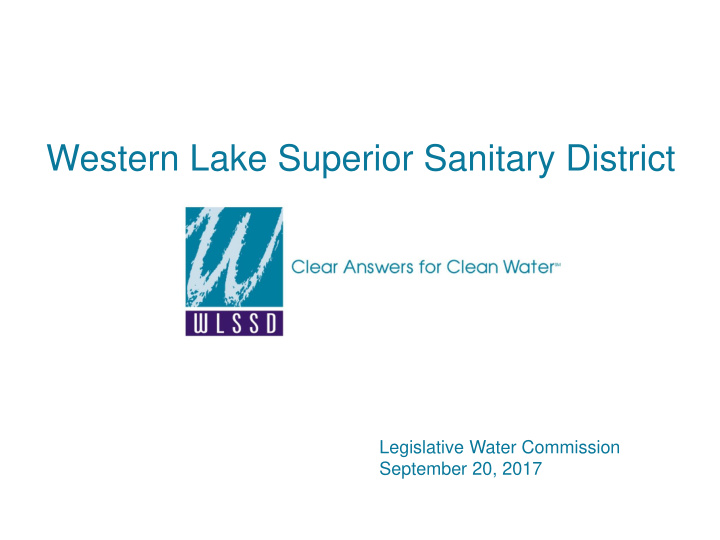



Western Lake Superior Sanitary District Legislative Water Commission September 20, 2017
Western Lake Superior Sanitary District History • Created by the Minnesota Legislature in 1971 – River terribly polluted. – Existing facilities were inadequate – 18 separate discharges into St. Louis River. • In 1974, Minnesota Legislature added full responsibility for solid waste management and planning • Plant began operations in 1978 - Treatment standards met on day one • River dramatically improved within 2 years • Today, the St. Louis River is an active walleye fishery and a resource for recreation, commerce and quality of life.
Board of Directors WLSSD is governed by a nine-member citizen board Seven of nine votes are required for any action • Four members appointed by the Mayor of Duluth and approved by City Council • Three members appointed by the Cloquet City Council • One elected by towns and cities in Carlton County outside of Cloquet • One elected by towns and cities in St. Louis County outside of Duluth
A Comprehensive Solution to Regional Problems 13.9 Billion Gallons/Year 530 Square Miles 16 Communities 4 Large Industrial Customers 1 Regional Treatment Plant WLSSD Serves Duluth Oliver, WI Cloquet Midway Township Hermantown Twin Lakes Township Rice Lake Duluth/North Shore Carlton Jay Cooke Wrenshall Proctor Scanlon Sappi Fine Paper Thomson Township Verso Paper Pike Lake USG Knife River Specialty Minerals
Clean Water… • WLSSD’s Treatment plant is designed to treat an average daily flow of 48 million gallons of wastewater a day Treats 13.9 billion gallons each year • 18 pumping stations move wastewater through a 78 mile network of interceptor sewers • Reducing pollution Industrial Pretreatment Program Household hazardous waste collection and pollution prevention education
Solid Waste • District was given solid waste responsibility by the MN legislature in 1974. Solid waste was used as a fuel to incinerate wastewater solids through the 1990s. • WLSSD Solid Waste Transfer Station opened in 1999 • Other programs: – Organics Composting – Household Hazardous Waste and Clean Shop – Materials Recovery Center
Biosolids Production and Land Application • $33 million production facility opened in 2001 • All WLSSD biosolids are applied by certified operators to local agricultural lands to produce feed crops and in mine land reclamation projects
The Next Generation of Power Biogas Harnessing Energy from Wastewater
Regionalization Opportunities and Challenges
Challenges to Further Expansion
Strategies for Dealing with Unsewered Areas
Big Lake Area Issues Failing on-site septic systems Limited onsite solutions on small lake lots Challenges Proximity to existing municipal wastewater treatment systems > 8 miles Limited affordable and technically feasible treatment options To provide off site treatment for nearly 350 existing homes Coordination between multiple governmental units Solutions Creation of the Big Lake Area Sanitary District (BLASD) Development of a regional solution with connection to the WLSSD treatment system Financial support from Federal and State
BLASD
Pike Lake Issues Failing on-site septic systems Limited onsite solutions on small lake lots with high water table and individual wells Challenges Lake split by 2 Townships Affordability and application of feasible treatment options Solutions Creation of the Pike Lake Area Wastewater Collection System (PLAWACS) Joint Powers Agreement between the two townships Connection to the WLSSD treatment system 4 million WIF Grant and 4 million low interest loan from PFA
PLAWCS
North Shore Issues Failing on-site septic systems Limited onsite solutions due to thin / unsuitable soils Challenges Proximity to existing municipal wastewater treatment systems Limited affordable and technically feasible treatment options Solutions Creation of the Duluth North Shore Sanitary District (DNSSD) and Knife River Sanitary District (KRSD) Development of a regional solution with connection to the WLSSD treatment system
DNSSD and KRSD map
Questions Marianne Bohren WLSSD Executive Director 218-740-4705 Marianne.Bohren@wlssd.com
Recommend
More recommend